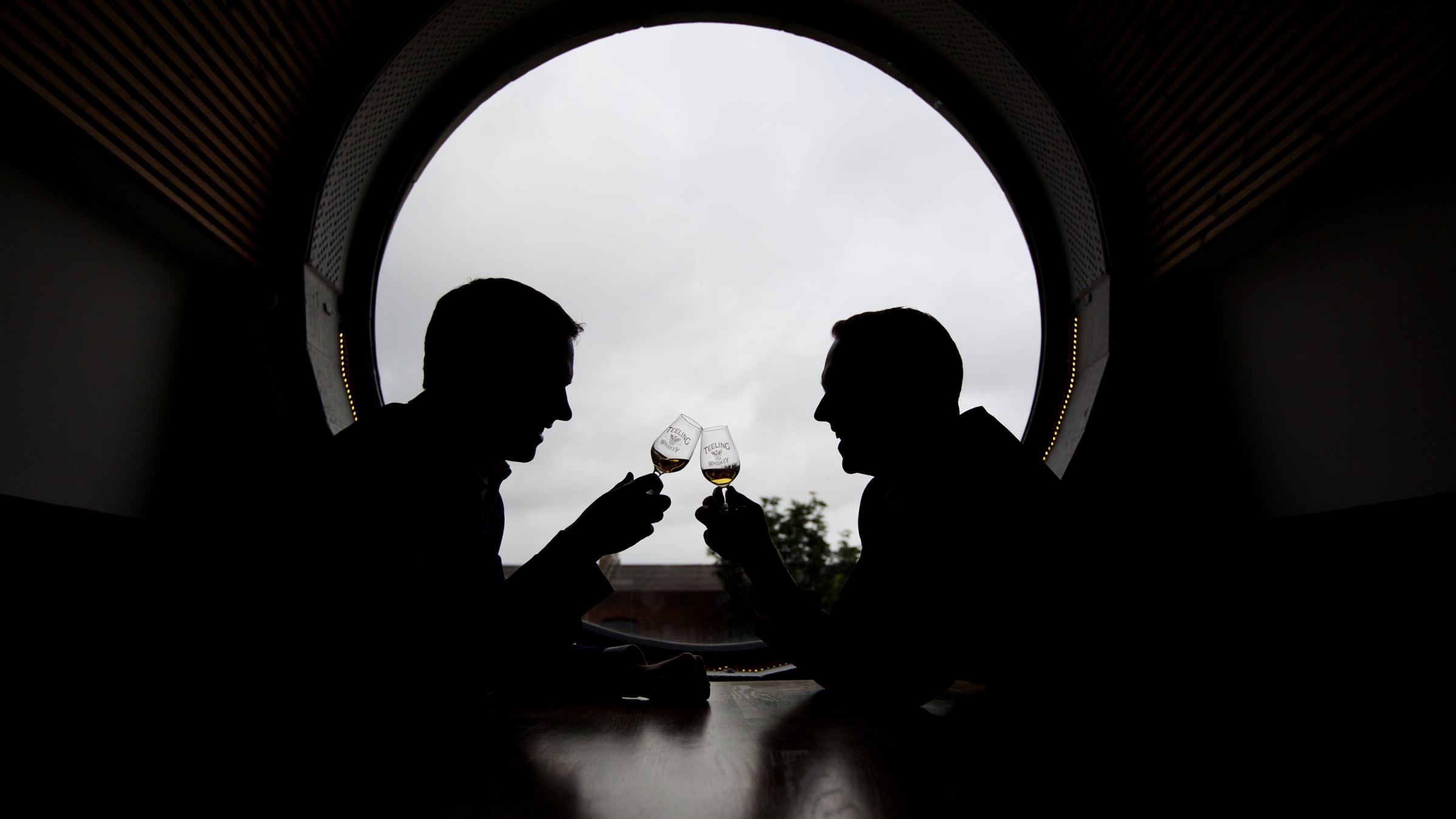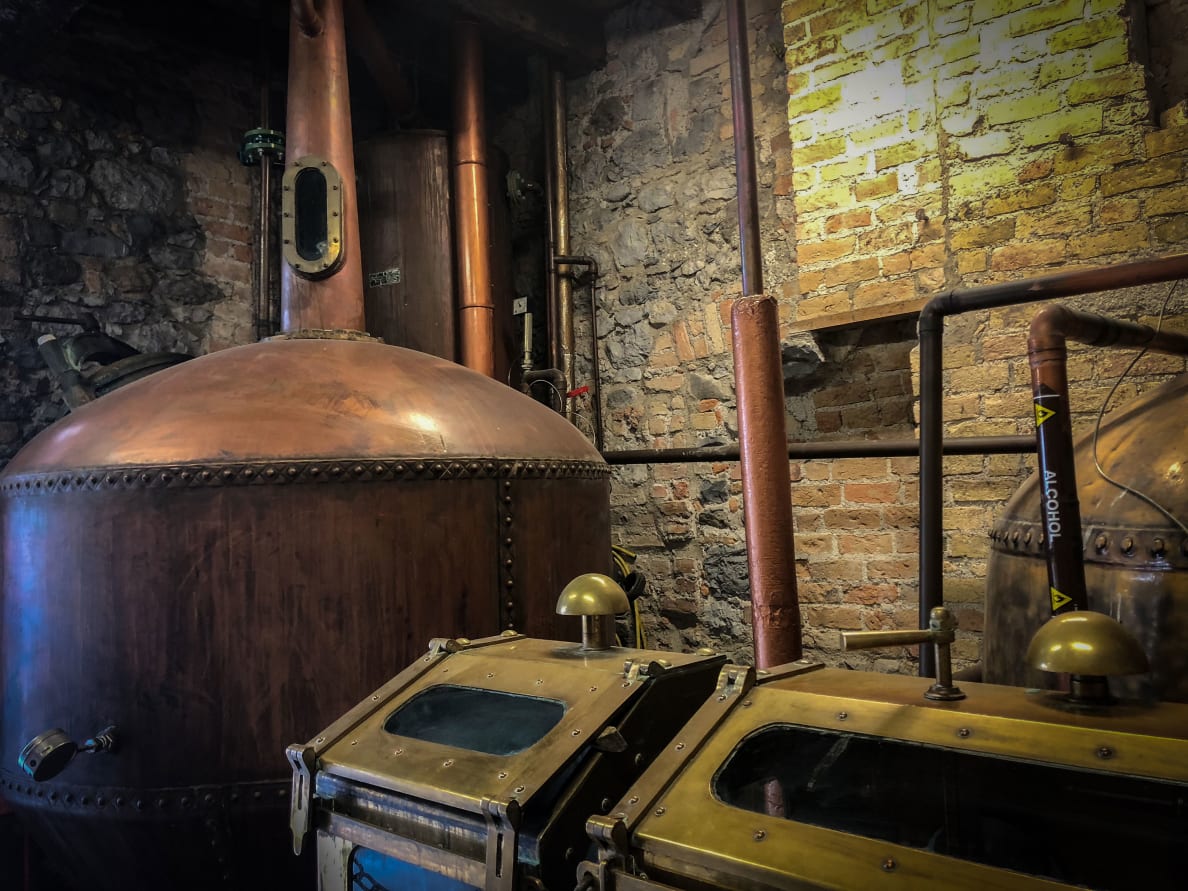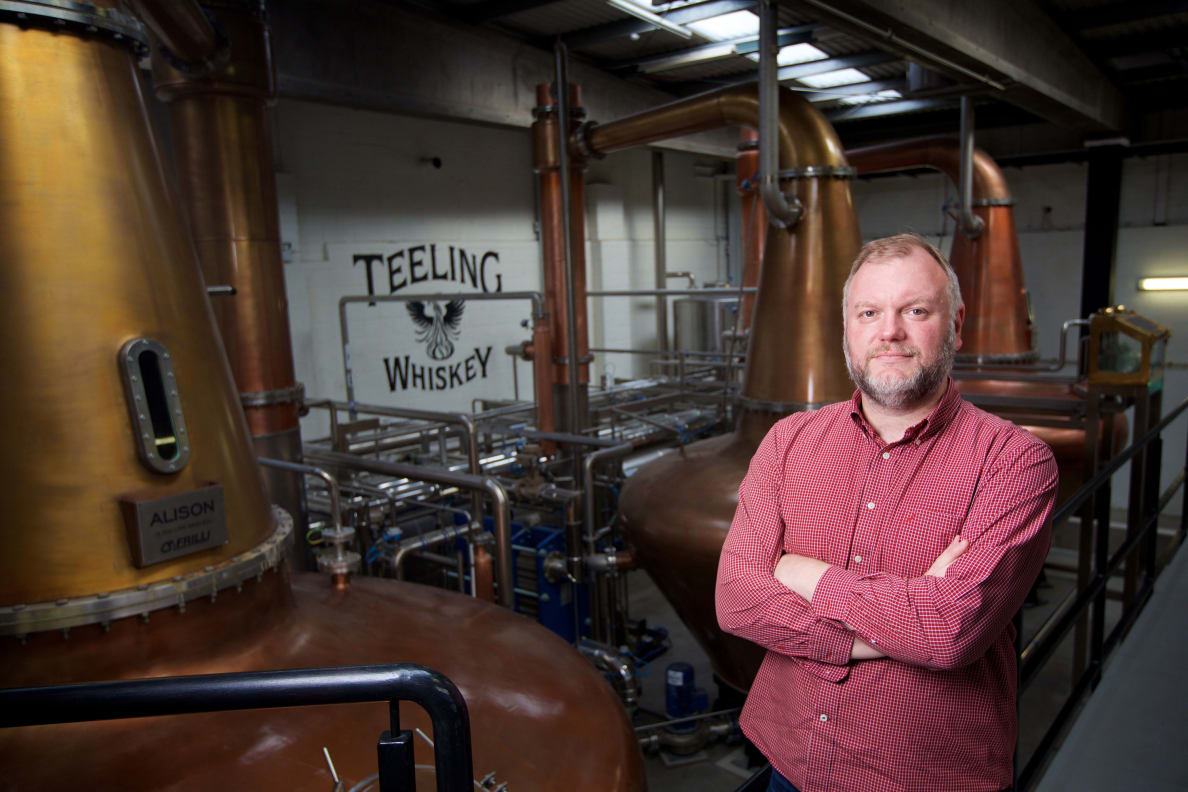Surfing the Ocean of Pot Still Irish Whiskey

Courtesy Teeling Whiskey
Pot still whiskey and poitín is now being produced by distillers around the Emerald Isle to great acclaim.
Irish whiskey has always come across as somewhat bashful, as if hiding behind the kilt of bawdy and braggadocios Scotch. Whiskey from Scotland was for barrel-chested brawlers; Irish whiskey seemed better suited for the drawing room. The blend was lighter, designed not to challenge but rather to provide something easily sippable neat or on ice.
Yet, the Irish whiskey of recent decades has been losing some of its bashfulness—and is increasingly coming out from behind the kilt, assuming its own bare-knuckle stance. (Note: This is not a reference to mixed martial arts champ Conor McGregor’s Proper Twelve Irish whiskey, released last year.)
Spirits from Ireland are trending bigger, rougher, shaggier. And these wooly beasts shamble in from two different directions: pot still whiskey that’s being revived in a big way. And from another revival: that of poitín (pronounced “poh-tcheen”), a rustic unaged whiskey that’s said to be to Irish whiskey what mezcal is to tequila.
Irish whiskey from pot stills is not actually new, of course. The distilling technology to make it is ancient and has been used in Ireland since the birth of whiskey.
Then in the 1830s an Irishman named Aeneas Coffey patented his more efficient column still, which allowed continuous production of spirits. Coffey’s still was more than efficient: it stripped out many of the heavier elements, leaving a lighter, brighter liquor. Pot stills continued to be employed, but in diminished capacity, with the output used in blends to boost flavor. Jameson, for instance, was typically half and half—50 percent pot still, smoothed out with an equal quantity of neutral grain whiskey from a column.
Owing to shifting consumer tastes (hello, vodka!), Irish distilleries nearly went extinct in the 1960s. But those dark years are over, and Irish whiskey has since come roaring back. Today, there are 26 distilleries in production, with more in the pipeline. And a number of the new distillers are looking to embolden Irish whiskey, in part by bringing back pot still variations.
“Everyone has a pot still whiskey aging,” says John Cashman, global brand ambassador for Irish whiskey with Beam Suntory, which makes Kilbeggan Irish Whiskey.
The Kilbeggan distillery was initially founded in 1757 but shuttered during the dark ages. It was revived in 2007, and among its distilling equipment is one of the oldest pot stills on the island—a steampunkish copper bulb with straining rivets that’s 185-years-old and notable for leaks pooling on the floor beneath. “It’s day by day,” admits Cashman. “We check it every morning.” Kilbeggan’s pot still whiskey is slated to land in U.S. markets early next year.

Courtesy Beam Suntory
Irish Distillers—the behemoth formed by a merger of three distilleries struggling to survive in 1966—produces industry leader Jameson and many other brands. Since the 1980s this has included Redbreast, Ireland’s leading single pot still whiskey, which is distilled in massive, 80,000-liter pot stills at the County Cork distillery.
Not content with Redbreast, Irish Distillers has been cooking up other pot still variations since 2015 at its micro-distillery not far from the main plant. The micro-distillery, with three pots stills with capacities of between 400 and 650 gallons, serves as a skunkworks and training ground for younger distillers, as well as an attraction for visitors. The micro-distillery produces a modest five barrels a week—compared to 2,500 barrels daily at the main distillery.
About a dozen products have been produced here under the Method & Madness label (this includes some experiments involving distillate from the main plant aged in Irish oak and other nontraditional woods.). Another whiskey in the works that’s still aging is one distilled twice rather than the customary three times, which head distiller Brian Nation says yielded a bigger, fruitier flavor. To date the only spirit released that had been made wholly at the micro-distillery has been a gin. But stay tuned for roll-outs of whiskey, few of which will have the lapidary smoothness of Jameson.
“We’re seeing what we call the Irish whiskey renaissance,” says Nation. “Single pot still is at the core of that.”
About 45 minutes north of Dublin is the Slane Whiskey Distillery. The original company, founded by Lord Henry Conyngham in 2009, began by sourcing and blending Irish whiskey. After partnering with U.S. spirits company Brown-Forman, Slane built its own distillery, which opened in 2017. It’s adjacent to a grand manor house on the 1,500-acre estate, which has been in the Conyngham family since 1703. They started by making a pot still whiskey; last year they also installed a column still. (The estate happens to be just upriver from still inventor Aeneas Coffey’s homestead. “Jump in the river, and you’d end up at his house,” says Alex Conyngham, Lord Henry’s son, who oversees the distillery.)
Slane is betting on increased global interest in pot still whiskey. “The pot still category will be the super-premium Irish whiskey in 10 to 20 years,” Conyngham says, predicting it will eventually rival the best single malt Scotches.
Near Dublin’s heritage distilling district, brothers Jack and Stephen Teeling built the first in the city’s wave of new distilleries four years ago. (Three other Dublin distilleries have since joined the Teelings.) Their initial releases were sourced from two other producers, including Cooley Distillery, which was founded by their father in 1987. But they’ve since shifted production to their own operation, led by distiller/blender Alex Chasko. Teeling’s first single pot still whiskey—given additional authority with non-chill-filtering and by bottling at 92 proof—was released in the fall of 2018.

Courtesy Teeling Whiskey
While pot still Irish whiskey tends to be rougher and raspier than its column-still cousins, poitín aims to be even more rustic. If pot still whiskey is building a house with unpainted wood, poitín is cobbling together a building from cast-offs.
Poitín has morphed fairly quickly from a very odd curiosity to a mildly curious oddity. The word means “small pot,” and for centuries was produced all over the island in farmyard sheds and backyard barns. The flavor profile ranges widely, depending in part on what it’s made of—barley, corn, potatoes, or sugar beets. Production was once so widespread and tax evasion so rampant that it was banned in 1661. The ban persisted for centuries (although didn’t stop production, naturally), until it was made legal again in 1997. In 2015 the Irish government issued production guidelines (poitín must be clear, unaged, and bottled at a minimum of 40-percent ABV), but it needn’t follow many of the other strictures that legally define Irish whiskey. Just as early distillers used whatever was at hand to make liquor, poitín makers today do the same.
Bar 1661 in Dublin opened this past summer aiming to showcase Irish spirits, especially poitín. It was founded by Dave Mulligan, who was inspired to do so in part after spending time with his sister in Mexico, and seeing how mezcal had gone from reviled country spirit to respected category. “Mezcal did not happen overnight,” Mulligan says. “It was years in the making.”
Mulligan offers poitín flights at his establishment for guests to compare the differing styles, including some made from unmalted barley. He says nine poitín distillers are currently producing on the island, issuing about 20 different bottlings. (He estimates another nine bottlings are in the pipeline.)
Mulligan himself makes Bán Poitín, an outsized, brassy, full-flavored poitín from a mash bill that combines malted barley, potato, and beet molasses. It’s made with his partners at Echlinville Distillery in Northern Ireland. Bartenders initially scoffed at his efforts to reintroduce this ancient white whiskey, but that attitude has softened, he says, and today there’s a burgeoning national pride in a native spirit that can give Scotch a run for its money. “We have Irish whiskey, we have Guinness, and we have this white Irish spirit,” Mulligan says. “And I see a space for it, especially in the cocktail world.”

Courtesy Beam Suntory
A half-century after facing extinction, Irish spirits are back from the brink. With their recovery assured and confidence rising, the island is ready to take on more established whiskies, and are looking to enter what some have called the “third golden age of Irish whiskey.”
“The revival is over,” says Jack Teeling, co-founder and managing director at Teeling Whiskey. “And the Renaissance is just beginning.”
